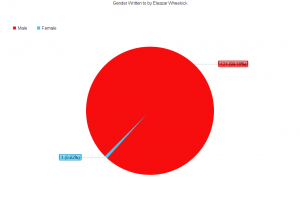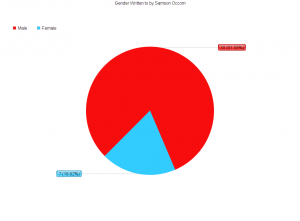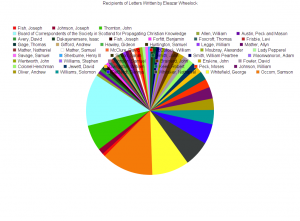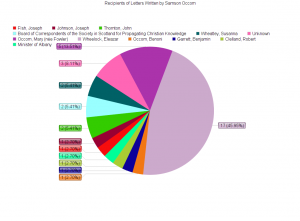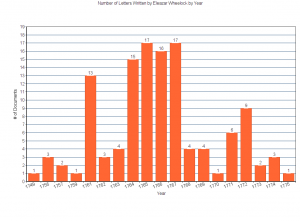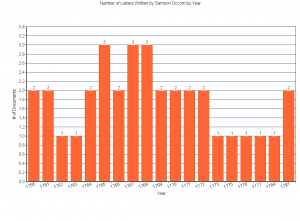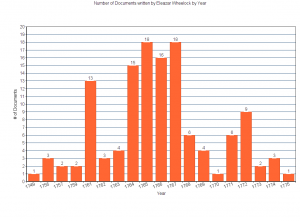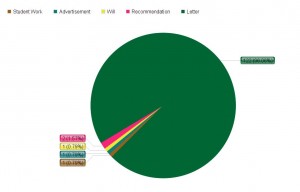This site is an experiment in “mapping” a digital archive. Mapping the Circle defines mapping as the use of visual tools (graphs and charts) to create another way of looking at archived writings. The purpose of this mapping is to create visual means of comparing data, more specifically, the archived writings of Samson Occom and Eleazar Wheelock in the Dartmouth Occom Circle project. The data used on the cite is taken from the archived letters of the Dartmouth Occom Circle Project. The numbers used are by no means representative of all writings ever done by Occom or Wheelock, simply those archived on the Occom Circle site.
What is the Occom Circle?
The following is a brief history and description as found on the Occom Circle website.
“Project History
In May 2005, the Dartmouth Alumni Office asked Ivy Schweitzer, professor of English, and Peter Carini, College Archivist, to present some of Occom’s papers to visiting alumni and members of the Mohegan tribe during Dartmouth’s annual pow-wow. Tribal elder Roland Harris, whose daughter graduated from Dartmouth, asked why, if Occom were as important as we claimed, he did not have a larger presence at Dartmouth. It was a good question with a complicated answer. In the 1769 Charter, founder Eleazar Wheelock describes the College’s mission first and foremost as “the education and instruction of youth of the Indian tribes in this land in reading, writing, and all parts of learning …” (http://www.dartmo.com/charter/index.html). Wheelock may have been saying what his overseas donors wanted to hear. Although Native students continued to enroll in small numbers at the College, it was only in 1972 under President John Kemeny that Dartmouth established its Native American Studies Program.
Intrigued and inspired by Harris’s query, Professor Schweitzer determined that a website dedicated to the works of Samson Occom would not only significantly increase Occom’s presence at Dartmouth, but also provide a teaching tool for academic courses, as well as a resource for students, teachers, scholars, alumni, the Mohegan tribe, and other Native Americans. In Fall of 2006, she applied for and received a one term Fellowship from the Dartmouth Center for the Advancement of Learning (DCAL dcal.dartmouth.edu) and over the next year––with a team comprised of the College Archivist, a website designer from Curricular Computing, a specialist in TEI markup, the librarian in charge of informational technology, and several student assistants––produced a prototype website. The team showed this prototype to a group of scholars and potential users, including Mohegan tribe linguist Stephanie Fielding and faculty in Dartmouth’s Native American Studies Program, in order to get feedback and flesh out the direction and parameters of the projected website.
In 2010, Professor Schweitzer applied for and received a grant from the National Endowment for the Humanities to create a Scholarly Digital Edition of the Occom materials; work began on the site in January 2011. Especially fitting is that The Occom Circle was awarded a “We the People” grant, a special initiative for projects that “explore significant events and themes in our nation’s history and culture” (wethepeople.gov/grants/).
Project Description
The Occom Circle does not merely replicate a conventionally printed edition of Occom’s collected works in digital form. Rather, employing the latest advances in digital markup technology, it offers users an expansive view of his world by including works written by Occom, but also about him and his activities by the members of his extensive and international circle of associates. This circle included some of the most influential figures in evangelical religion of the day, such as George Whitefield, the charismatic English Methodist preacher and major mover of the transatlantic Great Awakening. The project also includes correspondence between the key actors in Indian affairs in the second half of the 18th century, such as Sir William Johnson, the Crown’s agent; Eleazar Wheelock, mastermind of Indian education and missionizing; and Joseph Johnson, Occom’s brother-in-law and fellow Mohegan activist. Using the innovations offered by digital technology to cluster documents, search over multiple fields, and provide facsimiles and images, this digital edition places Occom at the center of a broad network of historical relations, allowing us to better appreciate the cultural world he inhabited and shaped” (www.dartmouth.edu/occom/project-history/)
All data and writings can be found at www.dartmouth.edu/occom/
Works Cited
“Project History.” The Occom Circle. Dartmouth College. 2014. Web. 03 March 2016.
“Project Description.” The Occom Circle. Dartmouth College. 2014. Web. 03 March 2016.

